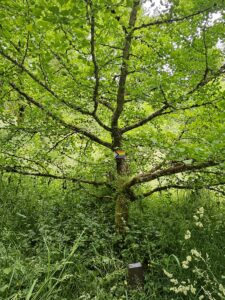This June we are wishing a very happy Pride Month to our Ginkgo biloba ‘Autumn Gold’! This tree came to us as a male tree, but has begun to produce female “fruits” [1]. This is a perfectly natural phenomenon that occurs across several species of plants.
Plants reproduce in a variety of ways, and can be monoecious, meaning they produce male and female organs on one plant, or dioecious, which means that male and female organs occur on separate plants. And, some plants produce flowers with both male and female organs, which are known as perfect or bisexual flowers.




Occasionally, dioecious plants may switch sexes or start producing female organs on a handful of branches depending on environmental factors. According to Mandy Tu, Hoyt Arboretum’s Plant Taxonomist and Herbarium Curator, this is relatively common in ginkgos.
If you find yourself visiting the ginkgos off the White Pine Trail, be sure to stop by and wish a happy pride to ‘Autumn Gold’! 🏳️⚧️🏳️🌈[2]


Footnotes:
- Since ginkgos are gymnosperms, they don’t produce true fruits–ie: the seeds do not form inside of an ovary. The fleshy, apricot-like structure that drops from female ginkgo trees is a seed with a fleshy outer layer called a sarcotesta–well known for smelling like rancid butter due to butyric acid.
- Please do not hang objects or decorations from the trees. The flag used in these photos was just a prop for the photo shoot. Thank you!
About the Author


